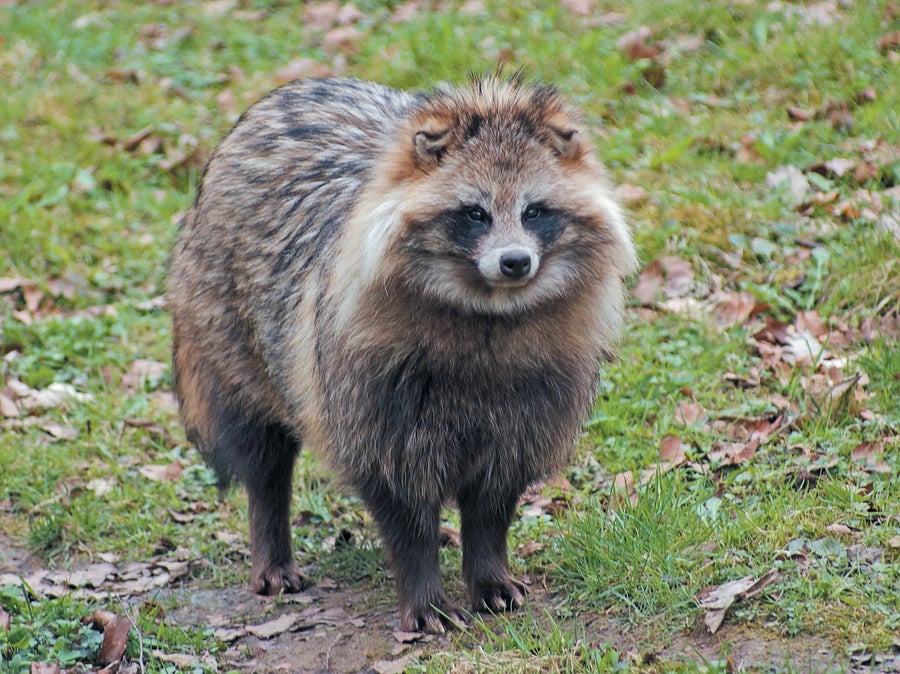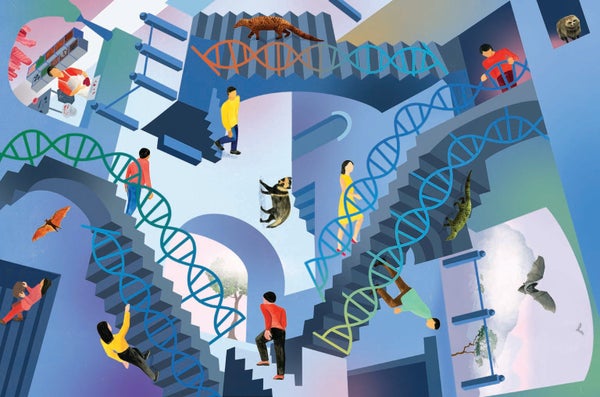The raccoon dog does not look particularly threatening. The small mammal resembles those familiar masked trash bandits that inspired its name, although it is most closely related to foxes. Raccoon dogs are native to the forests of eastern Asia, and the furry omnivores eat rodents, insects, crustaceans and plants. In China, they are commonly sold for their meat and fur. But recently the creature has become embroiled in the tense debate over the origin of the virus that causes COVID.
Genetic evidence collected by Chinese researchers in January 2020—and finally made public earlier this year—puts raccoon dogs and other wild animals at a market in Wuhan, China, that was the epicenter of many of the earliest human COVID cases. That same evidence puts the COVID-causing virus, SARS-CoV-2, in many of those same market stalls. Experiments have shown raccoon dogs can be infected with and transmit SARS-CoV-2. Taken together, many scientists say, these findings point to a scenario in which the virus jumped to people at the market. But other researchers emphasize this is only circumstantial evidence—although they agree it warrants further investigation—and still leaves open the possibility of a “lab leak” as the start of the pandemic.
There is no video footage of an infected raccoon dog sneezing on a human and giving them the virus. Even if slam-dunk epidemiological evidence exists, Chinese authorities have not been forthcoming about it. But finding a susceptible animal at the same place and around the same time that the first people caught COVID may be some of the best evidence we'll get, says Alex Crits-Christoph, a senior scientist in computational biology at Cultivarium, a nonprofit microbiology research organization.
On supporting science journalism
If you're enjoying this article, consider supporting our award-winning journalism by subscribing. By purchasing a subscription you are helping to ensure the future of impactful stories about the discoveries and ideas shaping our world today.
This twist to the origins search began in early March, when scientists at the Chinese Center for Disease Control and Prevention (CCDC) and their colleagues uploaded genetic data from swabs taken at the Huanan Seafood Wholesale Market to a scientific database. An international team of researchers led by Crits-Christoph found the overlapping genetic material of animals and the virus at the same spots in the market, a connection the Chinese researchers soon confirmed with their own analysis in Nature.
The proximity is key, says Angela Rasmussen, a virologist at the Vaccine and Infectious Disease Organization–International Vaccine Center in Saskatchewan and one of the collaborators on the international report. “It's not a ‘smoking raccoon dog,’ but it is pretty indicative that in exactly the same part of the market that our other analyses suggested we would find the animals, now we found them in that exact spot—with the virus and without, importantly, much human [DNA present],” Rasmussen says. The findings confirm previous reports that live animals were sold at that market, and evolutionary biologist Edward Holmes of the University of Sydney—a co-author of the international team's report—had photographed live raccoon dogs there several years earlier.
What the swab results don't do is confirm that the raccoon dogs or other animals were actually infected with the virus or that they were the animals that first spread it to people. The leading alternative scenario is that the virus leaked from one of several virology labs in Wuhan that conduct research on coronaviruses. And although there is no direct evidence for this or other theories, the new data cannot rule them out.

Raccoon dogs (Nyctereutes procyonoides) may have transmitted the COVID-causing virus to people, according to a recent genetic analysis. Credit: prill/Getty Images
Such lingering uncertainty isn't unusual: tracing the origin of a new viral disease can take decades. For instance, masked palm civets sold at an animal market in Guangdong, China, were identified as an intermediate host of the SARS virus that caused an epidemic in 2002–2003, but it took another 15 years to trace the source of the virus to bats; the origin of the Ebola virus, as well as those of many other viruses, has never been found. With SARS-CoV-2, the Chinese government's reticence to release all the data it has collected has hampered the origins search—for example, the CCDC team first released a preprint of the market data in 2022, two years after collecting them, and they didn't label the animal species present.
Many of the virus-positive samples were clustered in the market's southwestern corner, in the same place where stalls selling live animals were previously reported. Half a dozen virus-positive samples were also positive for raccoon dog DNA or RNA, often at higher amounts than human genetic material. One sample, known as Q61, contained a lot of raccoon dog material but very little human material. The report's authors also found genetic material from Amur hedgehogs, Malayan porcupines, masked palm civets, Siberian weasels, hoary bamboo rats, and other animals. Any of these species may have served as an intermediate host of the virus, which scientists believe likely originated in wild bats. Most of these other animals, however, have not been shown to be susceptible to SARS-CoV-2. Raccoon dogs have.
“This is not conclusive evidence that an animal was infected, but it's very consistent with that,” Crits-Christoph says. If the market were not the place where SARS-CoV-2 crossed from animals into people but instead the site of a superspreader event caused by people who were already infected, “you'd have to ask, Why there?” Crits-Christoph says. “If humans brought it there, why did they bring it to the place in Wuhan with the most stalls selling wild animals?”
Although the CCDC study in Nature confirms the genetic identification of animals sold at the market, it doesn't draw the same conclusions about their role. Instead the authors write that “these environmental samples cannot prove that the animals were infected.” And even if animals did carry the virus at the time of the market sampling, the CCDC researchers add, it is quite possible they picked it up from people—not the other way around.

In Whuan, the Huanan Seafood Wholesale Market was the site of many early COVID cases. Credit: Noel Celis/AFP via Getty Images
The international team's animal findings, however, build on previous studies supporting the market as an early epicenter of SARS-CoV-2 and suggesting multiple zoonotic origins linked to the market. One earlier research project was led by Jonathan Pekar, a doctoral student in biomedical informatics at the University of California, San Diego, and a co-author of the newer report on the market swabs. Pekar's group proposed that there were two lineages of the virus—A and B—circulating in Wuhan in the earliest days of the pandemic and that both were connected to the market. The B lineage is the first one believed to have infected humans. If the virus first jumped into people at the Wuhan Institute of Virology, as some people believe, researchers would have had to introduce it to the market twice, Rasmussen says.
“Is it possible that somebody working in the lab could have gotten infected with lineage B, showed up at the market and didn't infect anybody else on their way there, even though it's [about 10 miles away]—and then the next week the exact same thing happened with lineage A virus?” Rasmussen says. “It's possible, but I don't think it's very plausible, compared to the alternative: that lineage A and lineage B came from the animals, and then there were two separate spillovers.”
But the two-lineage interpretation has its critics. They have pointed out that these lineages differ by only two genetic mutations. Given how rapidly SARS-CoV-2 evolves, it is possible that one lineage evolved into the other after people brought it to the market, rather than requiring two separate human introduction events. “I don't think that the fact that, among the early viruses, they can be split into these two groups that differ by just two mutations really means that there had to be two introductions,” says Jesse Bloom, a computational biologist at the Fred Hutchinson Cancer Center in Seattle, who has studied the evolution of the virus. “It's also possible that one could have evolved into the other in humans.”
The animal evidence from the swabs does give scientists a better idea of where to look next for animals closer to the origin of the virus, Crits-Christoph says. Researchers can now focus their efforts upstream of the market, in the wildlife trade or on farms where these animals may have been bred. If a genetic sequence of the virus could be extracted from such an animal, Crits-Christoph says, it may be possible to tell whether a progenitor of the pandemic virus had been evolving in an animal host.
But these newer findings from the market don't quite fit the time line of the pandemic, a problem that researchers critical of the wildlife spillover theory are quick to point out. The samples were taken nearly a month after symptoms appeared in the first confirmed COVID cases, around December 10, 2019—and evolutionary genetic analyses suggest the virus began circulating in humans as early as mid-November of that year. It's impossible to know if the same animals were at the market then or whether they had been infected prior to the first human cases. “I think the major limitation is that, unfortunately, the sampling was being done in January 2020,” not the beginning of December 2019, Bloom says. “It's difficult to interpret what the correspondence between the animal and human content of these samples and the SARS-CoV-2 content means.”
Bloom released a preprint of his own analysis of the CCDC's data in late April 2023. It confirmed the presence of numerous animals at the market, including raccoon dogs. But Bloom went on to quantify the amount of DNA from different animals, and unlike Crits-Christoph's team, he included all animals with spinal cords (chordates), not just mammals. SARS-CoV-2 is only known to affect mammals, but Bloom included chordates as a control group. According to his analysis, very few of the SARS-CoV-2-positive samples contained a significant amount of raccoon dog DNA. In fact, the samples that contained the most virus also had the most genetic material from fish, which are not thought to be susceptible to the virus.
“What I take this to mean overall is that the genetic content of these samples—and the SARS-CoV-2 content of these samples—suggests that you can't really use that type of analysis to figure out if any animals were infected,” Bloom says. “It does not prove that animals were never infected; it just indicates that from these samples, you can't really conclude anything, because the type of signal you're looking for, you see it in things that clearly don't make any sense at all.”
Crits-Christoph does not buy that objection. He points out that correlations are not an appropriate way to answer the question of which specific animal shed the virus. The virus found in stalls selling seafood was almost certainly shed by sick humans. Of course, Crits-Christoph's own analysis is also based on a correlation: SARS-CoV-2-susceptible animals and parts of the market with positive virus samples. The difference, he says, is that he was merely using the correlation to show that the animals were there, not that any specific animal was infected at the time.
Alina Chan, a scientific adviser at the Broad Institute of the Massachusetts Institute of Technology and Harvard University, who has been an outspoken advocate of the lab leak hypothesis, has her own objections to the market stall data. The animal genetic sequences simply confirm there were animals at the Wuhan market, something that was already known, she says. “To me, it's not shocking that you would find raccoon dog material on these surfaces,” Chan says. She notes that SARS-CoV-2 was found all over the market, not just at the animal stalls.
Bloom, however, points out that lab leak theories rely just as much on circumstantial evidence as natural origin theories do. The main argument for leaks, he says, is proximity-based: “The outbreak started in Wuhan, where there are labs that study SARS-like coronaviruses. There's definitely no direct evidence that any of the labs were studying a virus identical to SARS-CoV-2.”
There are, Bloom thinks, four plausible scenarios by which the pandemic could have started. Two of them relate to a lab or a researcher: A scientist from one of the Wuhan Institute of Virology labs got infected by a bat while doing fieldwork, or a scientist at one of the labs collected a virus sample from a bat or other animal, brought the sample back to Wuhan and became infected while working with it in the lab. The other two scenarios involve natural spillover: A raccoon dog or other intermediate animal host directly infected a human in Wuhan or elsewhere, or a bat directly infected a person outside Wuhan, who then brought the virus back to the city (the bats that carry similar viruses aren't found in Wuhan). “In my mind, honestly, all these things sort of remain possible,” Bloom says. All these scenarios “are sufficiently worrying that we should try to mitigate them.”
Chan adds what she claims is another possible scenario for a lab-related origin: that the virus had been brought to a lab and, in an attempt to learn about how it mutates, was engineered to better infect human cells—and somehow got out into the world. This notion is highly controversial, and many scientists note that there is really no evidence for it. Chan and others have pointed to an unusual feature of the virus called a furin cleavage site as an indication that it was engineered. But such sites have also been found in other coronaviruses in nature, so this idea hasn't convinced many virologists and infectious disease specialists.
At least eight U.S. intelligence agencies have conducted their own investigations of the virus's origins. Four agencies concluded with “low confidence” that a natural spillover from animals is most likely, two favor a lab leak with “low” or “moderate” confidence, and two are undecided. The U.S. government has ordered information related to COVID origins to be declassified.
A firm answer to the origins puzzle has been elusive, but a hard puzzle is not an impossible one, Crits-Christoph says. He thinks scientists will keep getting closer. “People keep betting that no new information will come out, and new information keeps coming out,” he adds. “I would never make that bet. We're going to know more.”
